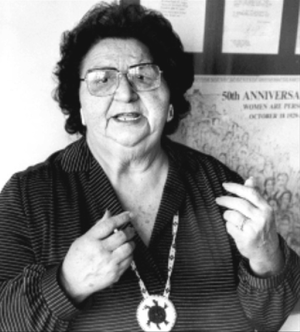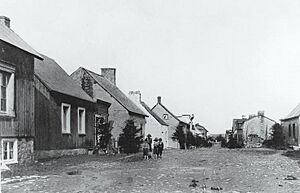Mary Two-Axe Earley facts for kids
Quick facts for kids
Mary Two-Axe Earley
|
|
|---|---|

Two-Axe Earley, c. 1970s
|
|
| Born |
Mary Two-Axe
October 4, 1911 |
| Died | August 21, 1996 (aged 84) |
| Resting place | Kahnawake |
| Nationality | Mohawk, Oneida |
| Occupation | Women's rights activist |
| Years active | 1967–1996 |
| Known for | Successfully leading the fight against legal gender discrimination in the Indian Act |
| Spouse(s) |
Edward Earley
(m. 1938; died 1969) |
| Children | 2 |
| Honours |
|
Mary Two-Axe Earley was a brave Mohawk and Oneida woman. She was born Mary Two-Axe on October 4, 1911, in Kahnawake, Quebec, Canada. She became a strong voice for women's rights.
Mary fought against unfair laws in the Indian Act. This law took away the "Indian status" of First Nations women. This happened if they married a man who did not have this status. Losing status meant losing important rights. Women could not live on their home reserves or take part in their community's life.
In 1967, Mary helped start a group called Equal Rights for Indian Women. She worked hard to change the Indian Act. She brought attention to these issues at big meetings. In 1975, she spoke out when her own community tried to evict her. This brought her national and international attention.
On June 28, 1985, the Canadian government changed the Indian Act. This new law, called Bill C-31, stopped the unfair treatment of women. It also allowed many First Nations women to get their status back. Mary Two-Axe Earley was the very first woman to have her status restored. Thanks to her, thousands of other women and their families got their rights back.
Contents
Early Life and Family
Mary Two-Axe was born in Kahnawake, a Mohawk reserve. Her father, Dominic Onenhariio Two-Axe, was Mohawk. Her mother, Juliet Smith, was an Oneida nurse and teacher.
When Mary was only 10, her mother sadly passed away. She died from a type of flu while helping sick people. Mary then lived with her grandparents in Kahnawake.
At 18, Mary moved to Brooklyn, New York, to find work. In 1938, she married Edward Earley, who was an Irish-American engineer. They had two children, Edward and Rosemary. The family would visit Kahnawake every summer.
Fighting for Change
Understanding the Indian Act
Mary Two-Axe Earley faced a big problem because of the Indian Act. This old law was unfair to First Nations women. If a First Nations woman married a man who did not have "Indian status," she would lose her own status. But if a First Nations man married a non-status woman, he kept his status.
Because Mary married Edward, who was not a "status Indian," she lost her rights. She could not own land on the Kahnawake reserve. She could not vote in reserve elections. She could not even be buried in the reserve's cemeteries. She also could not pass these rights to her children.
At first, Mary did not think much about losing her status. She was happy with her family. But over time, she saw how this unfair law hurt her friends. In 1966, a Mohawk friend died in her arms. This friend had been forced to leave Kahnawake because of the Indian Act. Mary believed the stress of losing her home contributed to her friend's death.
Leading the Movement
After her friend's death, Mary Two-Axe Earley decided to act. She started telling people across Canada about the problem. In 1967, she created the Equal Rights for Indian Women Association. This group later became known as Indian Rights for Indian Women. It grew into a national organization.
Mary reached out to Senator Thérèse Casgrain, a supporter of women's rights. Senator Casgrain encouraged Mary to share her story with a special government group. This group was called the Royal Commission on the Status of Women. Mary led 30 Mohawk women to speak to the Commission. They asked for the Indian Act to be changed. The Commission agreed that First Nations people should have equal rights, no matter their gender.
Mary faced strong opposition from some male First Nations leaders. They worried that allowing women and their children to return would cost too much money. Some also feared that allowing First Nations women to marry non-Indigenous men would weaken Indigenous culture.
In 1969, Mary's husband died. She decided to move back to Kahnawake. She had inherited a house there from her grandmother. But she was told she could not live there because she had lost her status. To get around this, she gave the house to her daughter. Her daughter had regained status by marrying a Mohawk man. Mary said she felt like "a guest in my own house."
In 1974, Mary helped start the Québec Native Women's Association. The next year, she went to a big meeting in Mexico called the International Women's Year Conference. While she was away, her community's council tried to officially evict her. Mary used the conference to tell everyone what was happening. This brought her a lot of attention. The eviction notice was then cancelled.
In 1982, Mary wanted to speak at a meeting of Canada's leaders. She was not allowed to speak. But Quebec's leader, René Lévesque, gave her his spot. Later that year, the Canadian Charter of Rights and Freedoms became law. This helped the cause of Indigenous gender equality gain more support.
Finally, on June 28, 1985, the Canadian Parliament passed Bill C-31. This new law removed the unfair gender rules from the Indian Act. It allowed women who had lost their status to get it back. Mary Two-Axe Earley was the first woman to have her status restored.
What Happened Next
The new law helped many people. About 16,000 First Nations women and 46,000 of their children could now get their Indian status back. In Kahnawake, almost 2,000 women became eligible to return. This led to new discussions in the community about who could be a member and how resources would be shared.
Some communities still did not want women to return, even with their restored status. In 1993, some First Nations groups went to court. They argued that the government should not decide who could be a band member. Even though she was 82 and had health problems, Mary Two-Axe Earley spoke in court. She explained how the old Indian Act had harmed First Nations women. The court decided that Bill C-31 would stay.
Awards and Honours
Mary Two-Axe Earley received many awards for her important work.
- In 1979, she won the Governor General's Persons Case Award. This award celebrates people who fight for women's rights.
- In 1981, she received an honorary law degree from York University.
- In 1985, she became an Officer of the National Order of Quebec. This is a high honour in Quebec.
- In 1990, she won the Robert S. Litvack Award from McGill University. She shared this award with other First Nations activists, Jeanette Lavell and Sandra Lovelace.
- In 1996, she received a National Aboriginal Achievement Award. This was for her work on Bill C-31.
On June 28, 2021, Google Doodle featured her. This was to celebrate the 36th anniversary of the Indian Act's amendment.
Death
Mary Two-Axe Earley lived in Kahnawake for the rest of her life. She passed away on August 21, 1996, at the age of 84. She died from breathing problems. She was buried in the Catholic cemetery on the Kahnawake reserve. This was a special wish she had, made possible by the legal changes she helped create.


